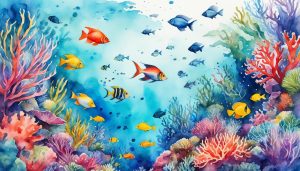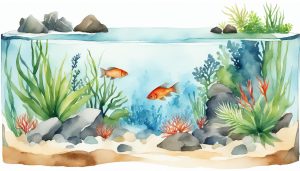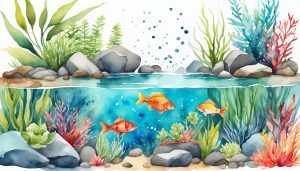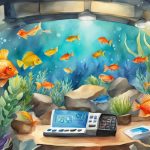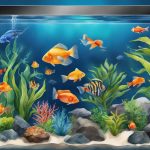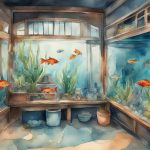When it comes to starting out with aquascaping, beginners can often feel overwhelmed by the wealth of information available. With so many techniques and styles to explore, it can be challenging to know where to begin. That’s why I’ve put together this beginner’s guide to basic aquascaping techniques. Whether you’re new to the world of aquascaping or just looking to refine your skills, these tips will help you create stunning underwater landscapes with ease.
Key Takeaways:
- Basic aquascaping techniques are essential for beginners to learn and master.
- Creating a visually appealing aquascape involves careful consideration of composition and focal points.
- The Rule of Thirds can help create a balanced layout by placing focal points at key intersections.
- There are different styles of aquascaping to explore, such as Iwagumi, Dutch, Nature, and Jungle.
- Start with simple and beginner-friendly techniques before diving into more complex designs.
The Rule of Thirds and Focal Points in Aquascaping
The Rule of Thirds is a fundamental compositional technique used in various art forms, including photography, painting, and aquascaping. In aquascaping, it helps create visually appealing and balanced layouts by dividing the aquascape into nine equal parts using imaginary lines.
By placing focal points at the intersection points of these lines, you can guide the viewer’s attention and add interest to your aquascape. Focal points are areas that stand out and draw the eye, creating a sense of harmony and visual engagement.
When implementing the Rule of Thirds in aquascaping, you can use various elements to create focal points. Here are a few examples:
- Rocks: Use differently shaped and textured rocks to create focal points within the aquascape.
- Driftwood: Utilize unique pieces of driftwood to add visual interest and attract attention.
- Plants: Incorporate plants of different colors, sizes, or textures to create focal points that contrast with the surrounding area.
By strategically placing these elements at the intersection points of the Rule of Thirds, you can achieve a sense of balance and harmony within your aquascape. This technique helps create a visually stunning composition that will captivate viewers and showcase your artistic skills.
Different Styles of Aquascaping
When it comes to aquascaping, there are various styles that cater to different preferences and aesthetics. Whether you prefer a minimalist and serene layout or a lush and vibrant underwater jungle, there is a style that will suit your taste.
One popular style is Iwagumi Aquascaping, which originated in Japan. It focuses on creating a sense of harmony and balance using rocks, typically arranged in a triangular pattern. The Iwagumi style often incorporates a few carefully selected plants to highlight the beauty of the rocks and create a serene, Zen-like atmosphere.
Another style that has gained popularity is Dutch Aquascaping, which is characterized by its lush and colorful plant compositions. Dutch aquascapes feature dense plantings with a variety of species and colors, creating a vibrant and natural-looking underwater garden. The arrangement of plants is carefully planned, with taller plants at the back and shorter ones in the front, creating depth and perspective.
Nature Aquascaping seeks to recreate natural aquatic environments, such as rivers, lakes, or even underwater meadows. It focuses on using a diverse range of plants, rocks, and roots to mimic the complexity and beauty of nature. Nature aquascapes often include driftwood to add a sense of realism and create hiding places for fish and other aquatic creatures.
If you prefer a more wild and untamed look, Jungle Aquascaping might be the style for you. It aims to replicate the lush density of a jungle by using a wide variety of plant species, creating a dense, chaotic, and visually striking aquascape. Jungle aquascapes often incorporate large leafy plants, mosses, and floating plants to create a sense of depth and abundance.


